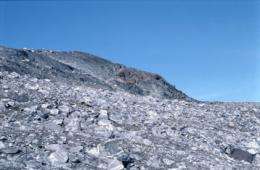A birthplace for primitive life on Earth?

The mud volcanoes at Isua, in south-west Greenland, have been identified as a possible birthplace for life on Earth by an international team headed by researchers from the Laboratoire de Géologie de Lyon: Terre, Planètes et Environnement. Almost four billion years ago, these volcanoes released chemical elements indispensable to the formation of the first biomolecules, under conditions favorable to life. It is the first time that such an environment, meeting all the requirements for the emergence of life, has been identified by scientists in 3.8 billion year- old formations. This work is published this week in the PNAS.
Serpentinite is a dark green mineral used in decoration and jewelry. In nature, it is formed when sea water infiltrates into the Earth's upper mantle, at depths that can reach 200 km in subduction zones. According to the scientists, this mineral, often found in the walls of hydrothermal sources, could play a major role in the appearance of the first biomolecules.
It has often been presumed that life developed near to hydrothermal sources known as black smokers, such as those found at the bottom of the oceans along mid-ocean ridges. The abundance of hydrogen, methane and ammonia produced by these underwater geysers seemed favorable to the emergence of primitive life. Unfortunately, these black smokers are very acid, which prevents amino-acid stabilization, and thus the formation of organic molecules.
The team of scientists publishing this article focused their studies on serpentinites from Isua, in south-west Greenland, which date from the start of the Archean(2). Dating back some 3.8 billion years, the rocks of Isua are some of the oldest in the world. Using isotopes of zinc as indicators of the basic or acid nature of an environment, the researchers highlighted the basic character of the thermal fluids that permeated the Isua serpentinites, thus demonstrating that these minerals formed a favorable environment for amino-acid stabilization.
The researchers also compared these serpentinites with recent equivalents from the mid-oceanic ridge of the Artic Ocean, the Alps and Mexico: the Isua rocks are markedly depleted in heavy isotopes of zinc compared to the latter. On the other hand, their zinc is isotopically similar to that from mud volcanoes of the Marianas Trench. Nearly four billion years ago, at a time when the continents only occupied a very small part of the surface area of the globe, the oceanic crust of Isua was permeated by basic hydrothermal fluids, rich in carbonates, and at temperatures ranging from 100 to 300°C. Phosphorous, another indispensable element to life, is abundant in environments where serpentinization takes place(3). As this process generates mud volcanoes, all the necessary conditions were gathered at Isua for organic molecules to form and be stable. The mud volcanoes at Isua thus represent a particularly favorable setting for the emergence of primitive terrestrial life.
More information: Early Archean serpentine mud volcanoes at Isua, Greenland, as a niche for early life. Marie-Laure Pons, et al. PNAS. On line in the week of 17 October 2011.
Provided by CNRS




















